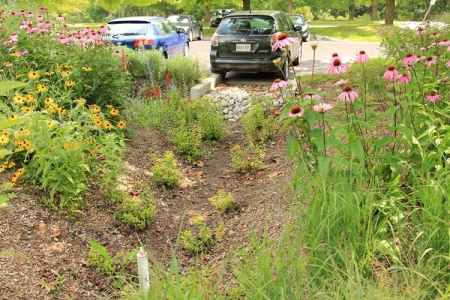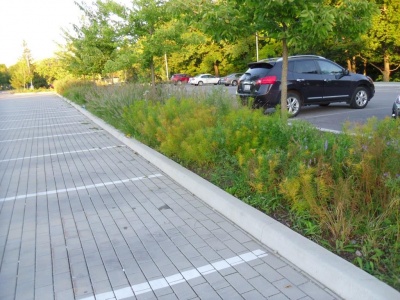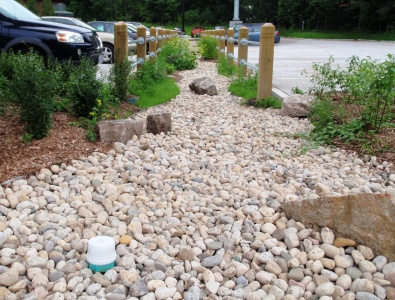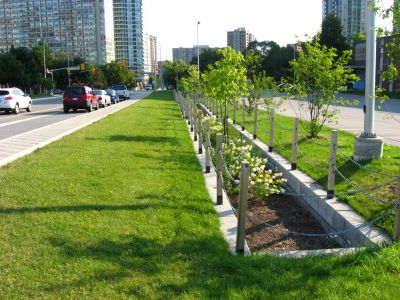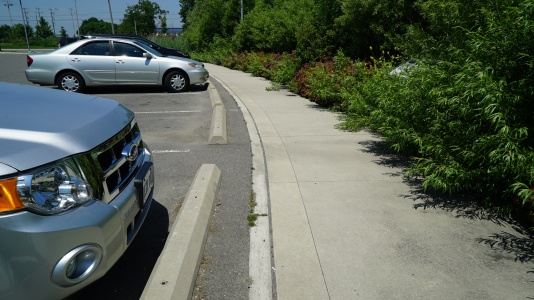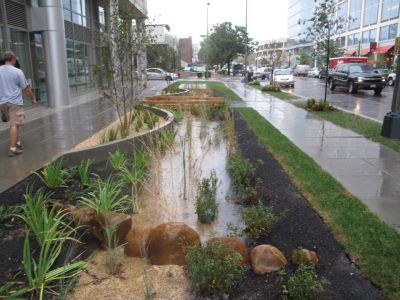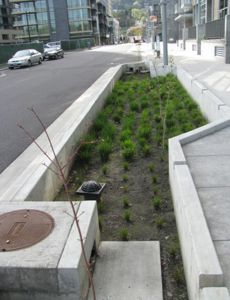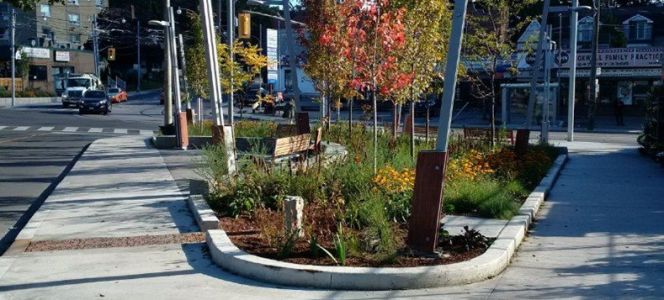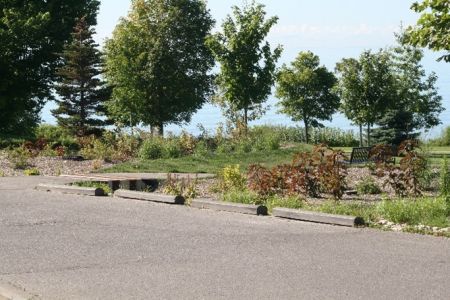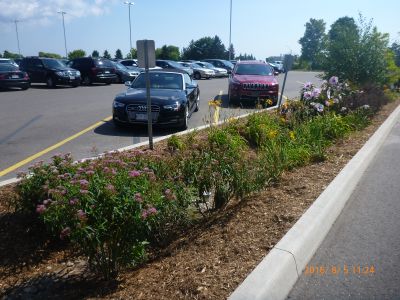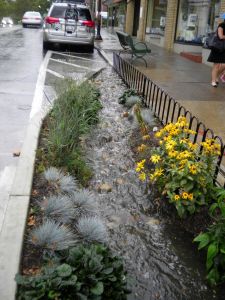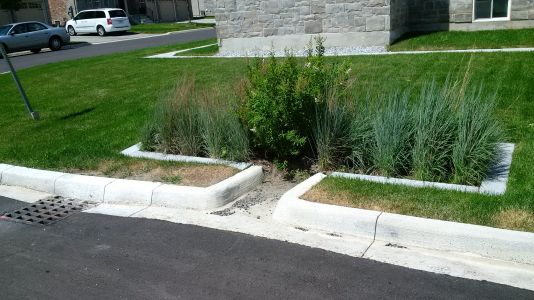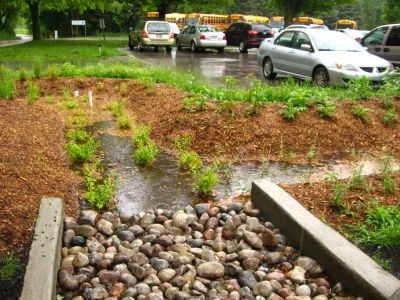Difference between revisions of "Bioretention: Parking lots"
Jenny Hill (talk | contribs) m |
Dean Young (talk | contribs) |
||
| (13 intermediate revisions by 2 users not shown) | |||
| Line 1: | Line 1: | ||
| − | [[ | + | <imagemap> |
| + | File:Bioretention Full Partial infiltration placementswap.png|thumb|600px|'''[[Bioretention: Partial infiltration|Partial infiltration bioretention]]''' cell draining a parking lot. Designs for this type of LID practice vary, but typically include a water storage reservoir, optional choker layer, filter media layer, mulch and vegetation. Other design variations include [[Bioretention: Full infiltration|'''full infiltration''']] and [[Stormwater planters|'''no infiltration''']] configurations which can be explored with their own image maps. <span style="color:red">'''''Note''': The following is an "image map", feel free to explore the image with your cursor and click on highlighted labels that appear to take you to corresponding pages on the Wiki.''</span> | ||
| + | |||
| + | |||
| + | |||
| + | |||
| + | rect 1295 2828 1342 3128 [[Underdrains|Underdrain Access Structure]] | ||
| + | rect 1296 1423 1348 1478 [[Underdrains|Underdrain Access Structure]] | ||
| + | rect 1293 3128 1346 3178 [[Underdrains|Underdrain]] | ||
| + | rect 1112 3181 1169 3250 [[Digital technologies|Water Level Sensor]] | ||
| + | rect 1134 3187 1159 3246 [[Digital technologies|Water Level Sensor]] | ||
| + | rect 1126 2838 1163 3187 [[Wells|Monitoring Well]] | ||
| + | rect 1116 1437 1163 1480 [[Wells|Monitoring Well]] | ||
| + | rect 1295 3183 1348 3254 [[Bioretention: Internal water storage|Internal Water Storage]] | ||
| + | rect 939 1415 1011 1482 [[Overflow|Overflow Outlet]] | ||
| + | rect 956 2845 1017 3177 [[Overflow|Overflow Outlet]] | ||
| + | rect 935 3229 1012 3285 [[Overflow|Overflow Outlet Pipe]] | ||
| + | poly 866 326 866 241 1386 241 1386 416 1392 683 1337 620 1270 579 1278 410 1241 339 1078 326 1045 398 1049 400 992 355 [[Mulch|Mulch]] | ||
| + | poly 870 685 868 610 1000 567 1004 632 [[Mulch|Mulch]] | ||
| + | poly 868 1028 966 1081 1021 1370 864 1485 870 1283 868 1211 870 1136 [[Mulch|Mulch]] | ||
| + | poly 990 1397 1045 1482 1110 1485 1111 1421 [[Mulch|Mulch]] | ||
| + | poly 1214 1389 1263 1419 1339 1440 1390 1446 1384 1491 1161 1497 [[Mulch|Mulch]] | ||
| + | poly 1292 1062 1386 1032 1384 1164 1249 1209 [[Mulch|Mulch]] | ||
| + | rect 1027 379 870 575 [[Stone|Erosion Control - Stone]] | ||
| + | rect 1241 1223 1392 1432 [[Stone|Erosion Control - Stone]] | ||
| + | rect 815 389 868 540 [[Curb cuts|Curb Cut]] | ||
| + | rect 1398 1234 1441 1378 [[Curb cuts|Curb Cut]] | ||
| + | rect 862 685 1388 1038 [[Trees: List|Tree]] | ||
| + | rect 1068 351 1245 648 [[Plant lists|Vegetation]] | ||
| + | rect 1007 1089 1235 1399 [[Plant lists|Vegetation]] | ||
| + | rect 854 1652 1408 2651 [[Trees: List|Tree]] | ||
| + | rect 1064 2684 1227 2822 [[Plant lists|Vegetation]] | ||
| + | rect 862 2863 955 2940 [[Flow through media|Ponding Depth]] | ||
| + | rect 1017 2902 1119 2942 [[Mulch|Mulch]] | ||
| + | rect 1164 2900 1398 2938 [[Mulch|Mulch]] | ||
| + | rect 864 2943 955 3079 [[Bioretention: Filter media|Filter Media]] | ||
| + | rect 1023 2941 1111 3083 [[Bioretention: Filter media|Filter Media]] | ||
| + | rect 1168 2938 1392 3081 [[Bioretention: Filter media|Filter Media]] | ||
| + | rect 866 3083 953 3116 [[Choker layer|Choker Layer]] | ||
| + | rect 1021 3079 1110 3116 [[Choker layer|Choker Layer]] | ||
| + | rect 1168 3085 1386 3116 [[Choker layer|Choker Layer]] | ||
| + | rect 868 3120 955 3185 [[Reservoir aggregate|Clear Stone / Aggregate]] | ||
| + | rect 1023 3114 1113 3189 [[Reservoir aggregate|Clear Stone / Aggregate]] | ||
| + | rect 1170 3116 1388 3191 [[Reservoir aggregate|Clear Stone / Aggregate]] | ||
| + | rect 1045 3252 1363 3309 [[Soil groups|Uncompacted Subgrade Soil]] | ||
| + | rect 900 3289 1047 3309 [[Soil groups|Uncompacted Subgrade Soil]] | ||
| + | |||
| + | |||
| + | </imagemap> | ||
| + | |||
| + | On commercial, industrial and multi-unit developments, a popular choice is to integrate [[bioretention]] into parking lot landscaped areas. These distributed cells typically accept sheet flow through multiple curb cuts, have shallow depression storage ≤ 100 mm, and a total area of 5 -200 m<sup>2</sup>. Although many parking lot schemes include long linear bioretention cells (≥ 0.6 m wide), infiltration is optimized by having a level grade and a level base, unlike a [[Bioswales|bioswale]]. | ||
| + | |||
| + | ===Winter maintenance=== | ||
| + | Salt can be damaging to the planting in parking lot bioretention. To help minimize this, bioretention practices adjacent to parking areas should always have an [[underdrain]] and salt use be reduced through good design and planning of the [[salt management| parking lot]]. | ||
| + | |||
| + | ==Gallery== | ||
| + | {{:Bioretention cells: Gallery}} | ||
| + | |||
| + | ==See Also== | ||
| + | *[[Bioretention: Streetscapes]] | ||
| + | *[[Stormwater planters]] | ||
| + | *[[Rain gardens]] | ||
| + | ---- | ||
| + | *[[Trees]] | ||
| + | *[[Perennials: List| Perennials]] | ||
| + | *[[Inlets]] | ||
| + | *[[Forebays]] | ||
| + | *[[Overflow]] | ||
| + | *[[Mulch]] | ||
| + | *[[Bioretention:_Filter_media|Filter media]] | ||
| + | *[[Choking layer]] | ||
| + | *[[Reservoir_aggregate|Reservoir]] | ||
| + | *[[underdrain]] | ||
Latest revision as of 20:57, 5 April 2022
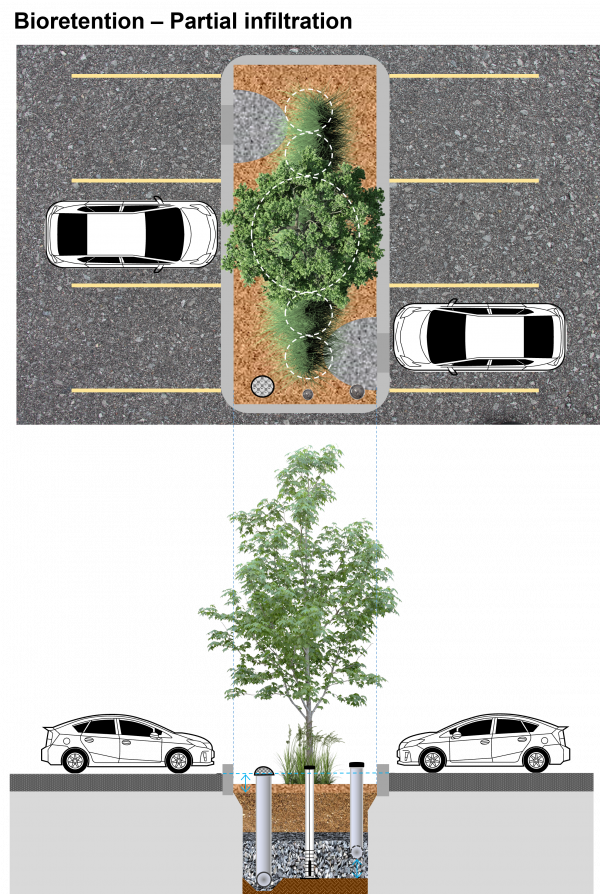
On commercial, industrial and multi-unit developments, a popular choice is to integrate bioretention into parking lot landscaped areas. These distributed cells typically accept sheet flow through multiple curb cuts, have shallow depression storage ≤ 100 mm, and a total area of 5 -200 m2. Although many parking lot schemes include long linear bioretention cells (≥ 0.6 m wide), infiltration is optimized by having a level grade and a level base, unlike a bioswale.
Winter maintenance[edit]
Salt can be damaging to the planting in parking lot bioretention. To help minimize this, bioretention practices adjacent to parking areas should always have an underdrain and salt use be reduced through good design and planning of the parking lot.
Gallery[edit]
Parking lot bioretention with surface ponding well in foreground, Kortright Centre, Vaughan, ON. Read about the performance of this practice in the technical brief.
Parking lot bioretention sharing underground reservoir with adjacent permeable paving, Edwards Gardens, Toronto, ON. Read a case study about it here.
Parking lot bioretention with decorative stone for erosion control, and perforated pipe access standpipe in foreground, Earth Rangers Centre, Vaughan, ON. Read about the performance of this practice in the technical brief.
The sunken curb holds the edge of the asphalt pavement and lets water freely flow to the bioretention cell beside the 7sigma parking lot in Minneapolis, MN (USA)
Photo credit:Brian AshBioretention cells on Elm Drive, Mississauga, ON, with vertical sides and hardscape perimeter receive road runoff via leader pipes from road catch basin inlets. Read about the stormwater system at this site in the performance assessment report.
Bioretention bump out in a dense urban setting receiving runoff via side inlet catch basin and curb openings on the walkway side of the installation.
Fairford Parkette featuring a bioretention cell retrofitted into a roadway in downtown Toronto, ON. Read a case study about it here.
Parking lot bioretention cell at IMAX corporate headquarters in Mississauga, ON. Read about the IMAX stormwater system in the performance assessment report
Bioretention cell receiving road runoff in the Wychwood neighbourhood of Brampton, ON. The nearby catch basin conveys overflows during major rain events. Read about the stormwater system in this community in the performance assessment report.
